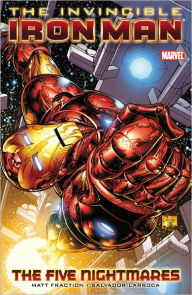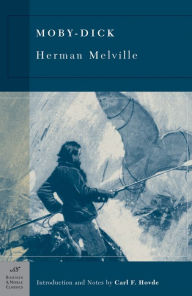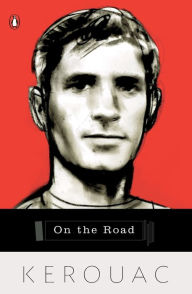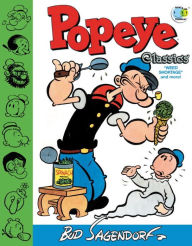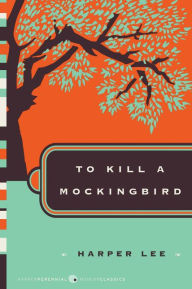10 Fictional Characters Based on Real People
The dirty secret of some fiction is that it’s less, well, fictional than we imagine. Behind every soaring flight of fancy, you’ll find grueling research, direct experience, and, sometimes, real human beings who inspired our favorite characters. While discovering that your favorite author isn’t above nicking from real life might be deflating, the tradeoff is realizing some of the most amazing characters from fiction actually existed, which is kind of like discovering magic is real. Here are 10 fictional characters you might be surprised to discover were based on very real people (or majestic beasts).
INVINCIBLE IRON MAN: FIVE
INVINCIBLE IRON MAN: FIVE
Paperback $19.99
Iron Man
Comic books frequently borrow from real life in order to fuel their stories, but it’s usually a little less obvious than with everyone’s favorite billionaire-playboy-superhero. Tony Stark is based (very obviously) on Howard Hughes; the connection makes a little more sense when you consider that Iron Man made his debut in 1963, when Hughes was still years away from his sad end. Back then, he was the eccentric, outspoken billionaire who invented technologies in a variety of fields. It probably wouldn’t have surprised anyone if the man who built the Spruce Goose had suddenly shown up to a press conference wearing a flying suit of armor.
Iron Man
Comic books frequently borrow from real life in order to fuel their stories, but it’s usually a little less obvious than with everyone’s favorite billionaire-playboy-superhero. Tony Stark is based (very obviously) on Howard Hughes; the connection makes a little more sense when you consider that Iron Man made his debut in 1963, when Hughes was still years away from his sad end. Back then, he was the eccentric, outspoken billionaire who invented technologies in a variety of fields. It probably wouldn’t have surprised anyone if the man who built the Spruce Goose had suddenly shown up to a press conference wearing a flying suit of armor.
Alice's Adventures in Wonderland and Through the Looking Glass (Barnes & Noble Classics Series)
Alice's Adventures in Wonderland and Through the Looking Glass (Barnes & Noble Classics Series)
By
Lewis Carroll
Introduction
Tan Lin
Illustrator
John Tenniel
Paperback $7.95
Alice from Alice’s Adventures in Wonderland, by Lewis Carroll
The best-known literary inspiration might be Alice Liddell, who, at the age of 10, met Charles Lutwidge Dodgson, the author of Alice’s Adventures in Wonderland (under the pen name Lewis Carroll). Dodgson became quite close with the Liddell family, especially young Alice, for whom he wrote the original story. The author took countless photographs of the young girl before abruptly breaking off his friendship with the family in 1863, when Alice was 11 years old. Liddell went on to marry into money and became a celebrated society figure, though she was forced to sell the original Dodgson manuscript at auction in later years to pay her bills.
Alice from Alice’s Adventures in Wonderland, by Lewis Carroll
The best-known literary inspiration might be Alice Liddell, who, at the age of 10, met Charles Lutwidge Dodgson, the author of Alice’s Adventures in Wonderland (under the pen name Lewis Carroll). Dodgson became quite close with the Liddell family, especially young Alice, for whom he wrote the original story. The author took countless photographs of the young girl before abruptly breaking off his friendship with the family in 1863, when Alice was 11 years old. Liddell went on to marry into money and became a celebrated society figure, though she was forced to sell the original Dodgson manuscript at auction in later years to pay her bills.
Moby-Dick (Barnes & Noble Classics Series)
Moby-Dick (Barnes & Noble Classics Series)
By
Herman Melville
Introduction
Carl F. Hovde
Paperback $11.95
Moby-Dick from Moby-Dick, by Herman Melville
That much of Moby Dick is based on actual, real-life stuff shouldn’t be a surprise; much of the novel reads like a 19th-century guide to the whaling industry. But the motif of the “white whale” that the obsessed Captain Ahab pursues to his doom seems so, well, literary that it must be made-up—except it isn’t. There really was a white whale (called Mocha Dick) famous for being a ferocious fighter as well as an unusually large and aggressive example of his species. While not the only white whale known to captains at the time, it’s almost certain Melville took inspiration from this actual creature. Mocha Dick was reportedly finally killed in 1838, although there was an alleged sighting a decade later, so who knows?
Moby-Dick from Moby-Dick, by Herman Melville
That much of Moby Dick is based on actual, real-life stuff shouldn’t be a surprise; much of the novel reads like a 19th-century guide to the whaling industry. But the motif of the “white whale” that the obsessed Captain Ahab pursues to his doom seems so, well, literary that it must be made-up—except it isn’t. There really was a white whale (called Mocha Dick) famous for being a ferocious fighter as well as an unusually large and aggressive example of his species. While not the only white whale known to captains at the time, it’s almost certain Melville took inspiration from this actual creature. Mocha Dick was reportedly finally killed in 1838, although there was an alleged sighting a decade later, so who knows?
Beloved (Pulitzer Prize Winner)
Beloved (Pulitzer Prize Winner)
In Stock Online
Paperback $17.00
Sethe from Beloved, by Toni Morrison
Anyone who has read Morrison’s Pulitzer Prize–winning novel likely had to compose themselves after the revelation of the shattering backstory of the main character, Sethe, an escaped slave who (spoiler alert!) killed her two-year-old daughter rather than see her snatched back to the plantation. The emotional response grows only more powerful when you learn Sethe was based on a slave named Margaret Garner, who fled from Kentucky to Ohio when one of the coldest winters in recorded history froze the Ohio River solid enough to serve as an escape route. When slave-catchers surrounded the house she had barricaded herself in, she did in fact kill her daughter, and when captured, was in the process of killing her other children in order to spare them a life of slavery. Margaret never stood trial; returned to her owners in Kentucky, she was moved frequently in a successful effort to hide her from the Northern authorities.
Sethe from Beloved, by Toni Morrison
Anyone who has read Morrison’s Pulitzer Prize–winning novel likely had to compose themselves after the revelation of the shattering backstory of the main character, Sethe, an escaped slave who (spoiler alert!) killed her two-year-old daughter rather than see her snatched back to the plantation. The emotional response grows only more powerful when you learn Sethe was based on a slave named Margaret Garner, who fled from Kentucky to Ohio when one of the coldest winters in recorded history froze the Ohio River solid enough to serve as an escape route. When slave-catchers surrounded the house she had barricaded herself in, she did in fact kill her daughter, and when captured, was in the process of killing her other children in order to spare them a life of slavery. Margaret never stood trial; returned to her owners in Kentucky, she was moved frequently in a successful effort to hide her from the Northern authorities.
Harry Potter and the Deathly Hallows (Harry Potter Series #7)
Harry Potter and the Deathly Hallows (Harry Potter Series #7)
In Stock Online
Paperback $14.99
Severus Snape from the Harry Potter series, by J.K. Rowling
J.K. Rowling based everyone’s favorite Slytherin on one of her former teachers, John Nettleship, who was surprised to learn of his role in the literary juggernaut. Nettleship, who passed away in 2011, was quoted as saying he was “horrified” when he heard what he’d inspired, saying, “I knew I was a strict teacher, but I didn’t think I was that bad.” He admitted he was “a short-tempered chemistry teacher with long hair…[and a] gloomy, malodorous laboratory,” and thus could see the connection. Considering Snape is arguably one of the most complex and interesting characters of all time, it’s not a bad legacy.
Severus Snape from the Harry Potter series, by J.K. Rowling
J.K. Rowling based everyone’s favorite Slytherin on one of her former teachers, John Nettleship, who was surprised to learn of his role in the literary juggernaut. Nettleship, who passed away in 2011, was quoted as saying he was “horrified” when he heard what he’d inspired, saying, “I knew I was a strict teacher, but I didn’t think I was that bad.” He admitted he was “a short-tempered chemistry teacher with long hair…[and a] gloomy, malodorous laboratory,” and thus could see the connection. Considering Snape is arguably one of the most complex and interesting characters of all time, it’s not a bad legacy.
The Fault in Our Stars
The Fault in Our Stars
By John Green
Hardcover $19.99
Hazel Grace Lancaster from The Fault in Our Stars, by John Green
No one who reads The Fault in Our Stars finishes it with a dry eye, and the feels become nearly unbearable when you learn that Hazel was inspired by an girl named Esther Earl, diagnosed with terminal cancer when she was 13. Earl met the author online and the two began a correspondence, and later met at a convention. While Hazel isn’t meant to literally be Esther, it’s clear she is the basis for the character, and one reason why Green’s portrayal of Hazel is so moving, and so real. Esther was a talented, spirited girl whose YouTube channel remains up and accessible, and whose writings were collected into the book This Star Won’t Go Out, published posthumously in 2014.
Hazel Grace Lancaster from The Fault in Our Stars, by John Green
No one who reads The Fault in Our Stars finishes it with a dry eye, and the feels become nearly unbearable when you learn that Hazel was inspired by an girl named Esther Earl, diagnosed with terminal cancer when she was 13. Earl met the author online and the two began a correspondence, and later met at a convention. While Hazel isn’t meant to literally be Esther, it’s clear she is the basis for the character, and one reason why Green’s portrayal of Hazel is so moving, and so real. Esther was a talented, spirited girl whose YouTube channel remains up and accessible, and whose writings were collected into the book This Star Won’t Go Out, published posthumously in 2014.
On the Road
On the Road
By Jack Kerouac
In Stock Online
Paperback $18.00
Dean Moriarity from On the Road, by Jack Kerouac
One of the best-known real people in a novel is Neal Cassady, the counterculture icon who was the basis for Dean Moriarity in On the Road (and who appears in other books, most notably The Electric Kool Aid Acid Test). In fact, this hardly counts as a secret, as the character was actually called Neal Cassady in the original draft. Cassady has a near-epic ability to sow enjoyable chaos in his own life and in the lives he touched, and his death, likely from exposure after he passed out in the open country, remains both tragic and totally fitting for a larger-than-life character.
Dean Moriarity from On the Road, by Jack Kerouac
One of the best-known real people in a novel is Neal Cassady, the counterculture icon who was the basis for Dean Moriarity in On the Road (and who appears in other books, most notably The Electric Kool Aid Acid Test). In fact, this hardly counts as a secret, as the character was actually called Neal Cassady in the original draft. Cassady has a near-epic ability to sow enjoyable chaos in his own life and in the lives he touched, and his death, likely from exposure after he passed out in the open country, remains both tragic and totally fitting for a larger-than-life character.
The Scarlet Letter (Barnes & Noble Classics Series)
The Scarlet Letter (Barnes & Noble Classics Series)
By
Nathaniel Hawthorne
Introduction
Nancy Stade
In Stock Online
Paperback $6.95
Hester Prynne from The Scarlet Letter, by Nathaniel Hawthorne
There are certain characters so firmly entrenched in the culture, it’s almost impossible to imagine the world that spawned them. Hester Prynne, central character of Hawthorne’s classic The Scarlet Letter, stems from a distant past (where names like “Hester” weren’t considered weird), and it’s a shock to realize she was probably inspired by a real person: Elizabeth Pain, a woman who had a child out of wedlock and was later accused of murdering that child. Although acquitted, she was convicted of negligence and sentenced to pay a fine and to receive a flogging (ah, the good old days). For an eerie moment, go find her tombstone in Boston and read the ending of the novel, and realize you’re looking at the same grave that Hawthorne is describing.
Hester Prynne from The Scarlet Letter, by Nathaniel Hawthorne
There are certain characters so firmly entrenched in the culture, it’s almost impossible to imagine the world that spawned them. Hester Prynne, central character of Hawthorne’s classic The Scarlet Letter, stems from a distant past (where names like “Hester” weren’t considered weird), and it’s a shock to realize she was probably inspired by a real person: Elizabeth Pain, a woman who had a child out of wedlock and was later accused of murdering that child. Although acquitted, she was convicted of negligence and sentenced to pay a fine and to receive a flogging (ah, the good old days). For an eerie moment, go find her tombstone in Boston and read the ending of the novel, and realize you’re looking at the same grave that Hawthorne is describing.
Popeye Classics: ''Weed Shortage'' and more! (Volume 6)
Popeye Classics: ''Weed Shortage'' and more! (Volume 6)
By
Bud Sagendorf
Editor
Clizia Gussoni
,
Craig Yoe
Hardcover $29.99
Popeye
Popeye the Sailor Man is a ridiculous figure: always chomping on a corncob pipe, always wearing his jaunty sailor hat, and such a slave to rage (and spinach) that when he’s not speaking authentic shanty gibberish, he’s beating everyone to a pulp. Obviously the creation of a fevered Prohibition-era brain desperate for alcohol, right? Except, the creator of Popeye, Elzie Crisler Segar, lived in Chester, Illinois, where a man named Frank “Rocky” Fiegel lived. Fiegel chomped on a pipe, wore a jaunty hat, and was constantly fighting with anyone who looked at him funny, often taking on multiple opponents. Fiegel is widely believed to be the inspiration for Popeye, and his grave even features an image of the character.
Popeye
Popeye the Sailor Man is a ridiculous figure: always chomping on a corncob pipe, always wearing his jaunty sailor hat, and such a slave to rage (and spinach) that when he’s not speaking authentic shanty gibberish, he’s beating everyone to a pulp. Obviously the creation of a fevered Prohibition-era brain desperate for alcohol, right? Except, the creator of Popeye, Elzie Crisler Segar, lived in Chester, Illinois, where a man named Frank “Rocky” Fiegel lived. Fiegel chomped on a pipe, wore a jaunty hat, and was constantly fighting with anyone who looked at him funny, often taking on multiple opponents. Fiegel is widely believed to be the inspiration for Popeye, and his grave even features an image of the character.
To Kill a Mockingbird
To Kill a Mockingbird
By Harper Lee
In Stock Online
Paperback $20.00
Dill Harris from To Kill a Mockingbird, by Harper Lee
With the passing of Harper Lee this year, many readers discovered and re-discovered the joys of her remarkable 1960 novel. Berkeley Breathed even published a special Bloom County cartoon informing us that while everyone always thought Harper was the basis for Scout, he believed she was actually the basis for Boo Radley, the shy, disturbed, and ultimately heroic recluse living next door to the Finches. But Lee probably did see herself in Scout, because she blatantly based the character of Dill, Scout’s best friend and asserted future husband, on her own bestie, Truman Capote. To be fair, Capote could also have been the basis for Boo. Let’s just face it: we’re all Boo to some extent.
Dill Harris from To Kill a Mockingbird, by Harper Lee
With the passing of Harper Lee this year, many readers discovered and re-discovered the joys of her remarkable 1960 novel. Berkeley Breathed even published a special Bloom County cartoon informing us that while everyone always thought Harper was the basis for Scout, he believed she was actually the basis for Boo Radley, the shy, disturbed, and ultimately heroic recluse living next door to the Finches. But Lee probably did see herself in Scout, because she blatantly based the character of Dill, Scout’s best friend and asserted future husband, on her own bestie, Truman Capote. To be fair, Capote could also have been the basis for Boo. Let’s just face it: we’re all Boo to some extent.
